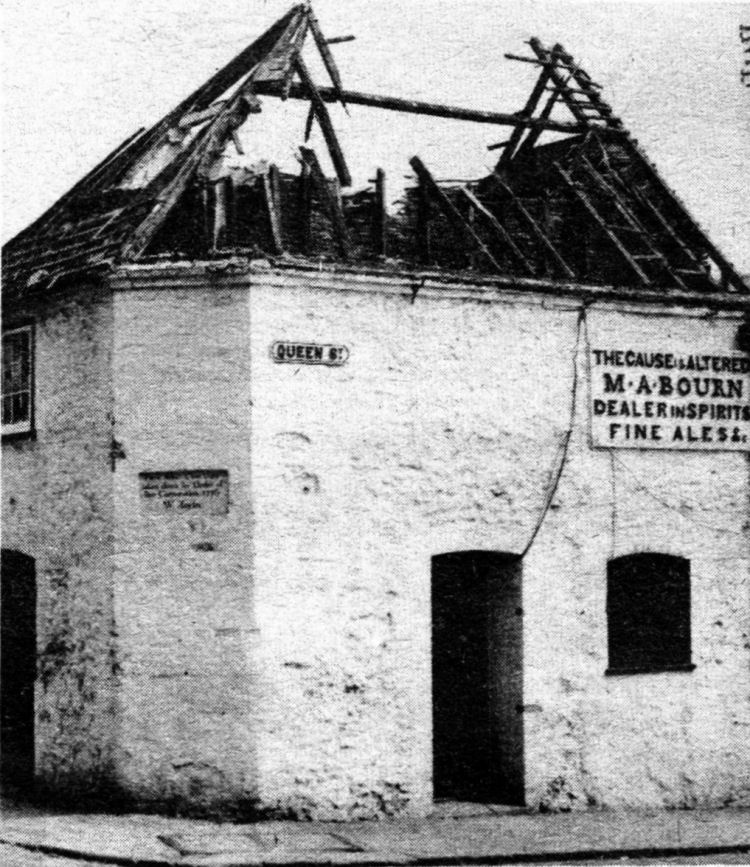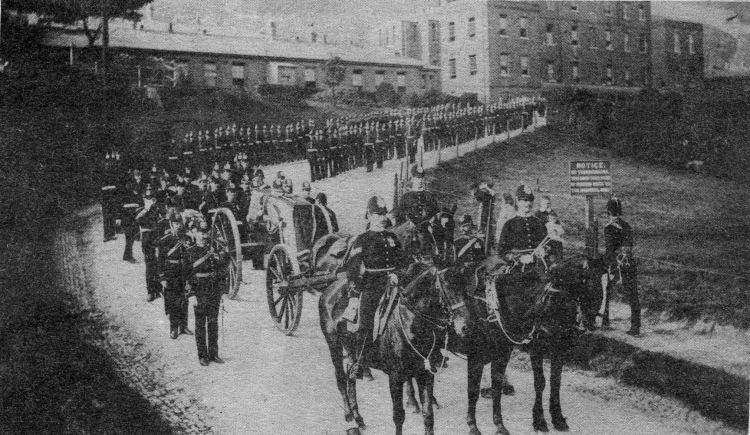Page Updated:- Sunday, 07 March, 2021. |
|||||
 Published in the South Kent Gazette, 31 October, 1979. A PERAMBULATION OF THE TOWN, PORT AND FORTRESS. PART 31.
JOHN TREVANION. The Queen Street charity school of 1879 was practically the first public effort to bring the advantages of education within the reach of the children of the working man. Although the facade of the school recently demolished had an inscription on the exterior showing that it was founded in 1789, we believe there was a similar effort a little earlier. Mr. John Trevanion, a Dover man, who had ambition to represent the borough in Parliament, fought, unsuccessfully, a bye-election in 1769; and at the General Election of 1774 he tried again, when he was successful. As a thanks offering he instituted in the now disappeared Council House Street, on the site of the Artizan’s Dwellings, a school for the education of 50 boys and he continued that school as long as he was a Member of Parliament for Dover — that was until 1803. The Charity school, established for a like purpose in 1789, was lower down Queen Street on part of the site now occupied by the old covered Market and in close proximity to the town prison of the period. It was founded to train forty boys and twenty girls, the religious training to be in accordance with the Church of England. The arrangement as to teachers’ pay was, more strictly than in modem times, regulated by results, the scale being £1 per year for each child. As a master and mistress had to be kept, it was found necessary to enlarge the school to afford a living wage, and the number was increased to 65 boys and 45 girls. In 1820, benefactions had sufficiently increased the fund to enable the trustees to erect the school on the south side of Queen Street, together with a dwelling' for the master and mistress. Two lofty rooms afforded sufficient accommodation for 200 boys and 200 girls, the school not being then a St. Mary’s Parish affair, but open to all poor children in the town and neighbourhood. The following list of donations, extending over nearly sixty years, will indicate the sources by which it was supported: 1813 Mr. W. Bond, for two prizes, to be paid from yearly interest............£21 0 0 1814 Peter Fector, Esq............. £200 0 0 1815 Miss Mary Fector ............ £10 0 0 1815 B. E. Stowe, Esq., per Committee of the Stock Exchange .. .......... £300 0 0 1816 Mr. J. Pierce................................ £5 0 0 1819 Mrs. Ann Howell..............£10 0 0 1819 Mr. Thos. Patrick ............ £100 0 0 1820 Mr. A. H. Wellard ............ £50 0 0 1821 J. M. Feotor, Esq............. £200 0 0 1825 Mrs J. Gunman............................ £25 0 0 1825 Archbishop Sutton ............ £25 0 0 1829 Mr. Geo Friend............................ £50 0 0 1830 Archbishop Howley............£10 0 0 1831 Mr. Latham Osborne........................ £10 0 0 1931 Mr. Chas. E. Pigou............. £10 0 0 1834 Miss Latham ............................ £50 0 0 1839 Mr. G. Hazlerigg............................ £10 0 0 1840 J. Curteis, Esq., in four donations .... £41 10 0 1847 G. R. P. Jervis, Esq ............ £100 0 0 1854 Napoleon III, Emperor of France ..... £10 0 0 1855 Edward Phillips, Esq. ...... £100 0 0 1870 Mrs. Ann Francis ............ £10 0 0 After the Education Act of 1870 come into operation, this School became united under Trust Deeds with the National Education Society. Not far above the school was the Friends’ Meeting House, enclosed within a courtyard by a high wall. It was built in the year 1802. The Society of Friends came to Dover about the year 1655, and opened a meeting house near the bottom of St. Jame’s Street. In 1660 they purchased land adjoining Woolcomber Street, where they had a meeting house and burial ground until they migrated to Queen Street at the beginning of the last century, where they met for worship for more than 100 years, later moving to Maison Dieu Road.
THE “CAUSE IS ALTERED.“ On the north side at the top of Queen Street until it was needlessly destroyed, as it turned out, to make way for the York Street dual carriageway, stood an ancient inn, bearing the curious name "The Cause is Altered.“ This house was just within Cowgate, and must have been there long before that gate was removed. The name was in bold raised letters over the door, and an old inhabitant told the author that he saw that particular sign fixed there before he went to sea in the year 1826. The sign of this house was originally ‘‘The Black Horse,“ (sic, it was the "Blacksmith's Arms") and being situate in a lonely spot on the walls, was a resort of smugglers, but when Mr. Bourne took the house at the beginning of the nineteenth century, he resolved to make a change for the better, and put up the new sign “The Cause is altered.“ (Sic the name predates Bourne.)

The Cause is Altered public house (pictured right) at the top of Queen Street, was demolished in June 1971 to make way for the York Street dual carriageway. Because it was one of Dover’s few surviving ancient buildings and probably the oldest in domestic occupation, there was a campaign to save it or preserve a remnant — such as a plaque on the corner which recorded that “ Here stood Cow Gate, taken down by order of the Corporation, 1776.“ Next door was St Mary’s Infants’ School which was also demolished.
POET CHURCHILL’S GRAVE. Just beyond Cowgate, at the foot of Durham Hill, facing what used to be Princes Street, stood a long blank wall of mixed stone, the material of which evidently came from the town wall. This formed the back of a low building in Ruffin’s Court, the entrance to which was round the corner, facing St. Martin’s old burial ground. Ruffin, who was a builder in a small way, was also the Sexton of St. Martin’s burial ground. When Lord Byron visited it in the year 1816 to find the poet Churchill’s grave, Byron asked Ruffin to point out the reply, thus — “ Well, I do not know, Why frequent travellers turn to pilgrims so: He died, before my day of Sextonship, And X had not the digging of his grave,“ "I believe the man of whom. You wot, who lies in this selected tomb, Was a most famous writer in his day. And therefore travellers step from out their way, To pay him honour — and myself whate’er Your honour pleases." Then most pleased I shook From out my pocket's avaricious nook Some certain coins of silver..... .....I did dwell. With a deep thought, and with a soften’d eye. On that old Sexton’s natural homily, In which there was Obscurity and Fame. The Glory and the Nothing of a Name.

Much public sympathy was aroused in 1860 when the bursting of a gun at Archcliffe Fort caused the death of Sergeant Monger, a volunteer, during an exercise. Pictured above is the cortege leaving the South Front Hospital, on the Western Heights, for the funeral at Cowgate Cemetery.
|
|||||
|
If anyone should have any a better picture than any on this page, or think I should add one they have, please email me at the following address:-
|
|||||
| LAST PAGE |
|
MENU PAGE |
|
NEXT PAGE | |